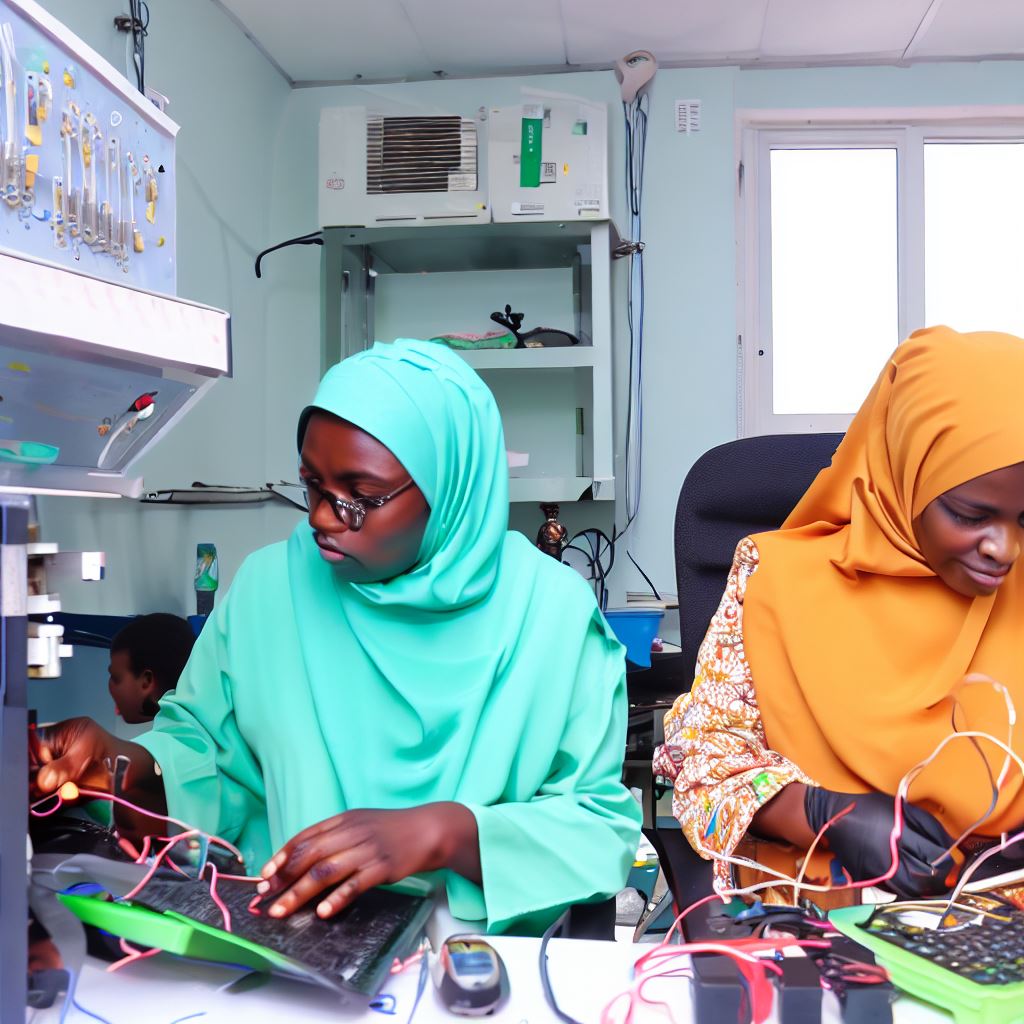Introduction
Photonics technologies refer to the science and application of generating, controlling, and detecting light.
Photonics technologies are crucial in various aspects of modern society, such as telecommunications, healthcare, and energy.
This blog section focuses on the specific impact and relevance of photonics technologies in Nigeria.
Understanding Photonics Technologies:
Photonics involves the study and manipulation of photons (light particles) for various applications, including optics and lasers.
Importance of Photonics Technologies:
- Communication: Photonics powers high-speed data transmission via optical fibers, enabling the internet and telecommunication.
- Medicine: Laser-based medical procedures improve precision in surgery, diagnosis, and treatments.
- Manufacturing: Photonics enhances precision in manufacturing processes, reducing errors and waste.
- Energy: Photovoltaics convert sunlight into electricity, contributing to clean energy solutions.
- Defense: Laser technology aids in defense systems, from targeting to communication.
- Research: Photonics supports scientific research in fields like astronomy, chemistry, and biology.
Photonics Technologies in Nigeria:
Nigeria recognizes the potential of photonics technologies and is making strides in:
- Research: Advancing photonics research in academic institutions.
- Education: Offering photonics-related courses and training programs.
- Industry: Integrating photonics into various sectors, from healthcare to telecommunications.
- Innovation: Fostering startups and initiatives centered around photonics applications.
As photonics technologies continue to evolve and expand, Nigeria’s investment in this field promises to drive innovation, improve infrastructure, and positively impact various aspects of modern society.
Understanding Photonics Technologies
Definition and explanation of photonics technologies
- Photonics technologies refer to the use of photons (particles of light) to generate, manipulate, and detect light.
- These technologies involve the study and application of various aspects of light, such as its emission, transmission, modulation, and detection.
- They rely on the principles of quantum mechanics and optics to harness the unique properties of light.
Key applications and industries utilizing photonics technologies
- Telecommunications: Photonics technologies play a crucial role in fiber optic communication systems, enabling high-speed data transmission over long distances.
- Information technology: They are used in the development of optical storage devices, such as CDs and DVDs, which provide efficient data storage and retrieval.
- Medical and healthcare: Photonics technologies are employed in medical imaging, laser surgeries, and diagnostics, facilitating accurate diagnostics and treatment.
- Manufacturing and industrial processes: They find applications in laser-based manufacturing processes, including cutting, welding, and marking, improving efficiency and precision.
- Renewable energy: Photonics technologies are utilized in solar cells and photovoltaic systems, converting sunlight into electricity.
- Defense and security: They are used in the development of advanced surveillance systems, laser-based weapons, and optical communication in military applications.
Importance of photonics technologies in various sectors
Photonics technologies have a significant impact across multiple sectors in Nigeria:
- Economic growth and development: Adoption of photonics technologies can drive innovation, productivity, and competitiveness, leading to economic growth.
- Energy efficiency: Photonics technologies, such as LED lighting and solar cells, contribute to reducing energy consumption and promoting sustainable development.
- Healthcare advancements: Photonics-based medical applications improve diagnosis accuracy, enable minimally invasive surgeries, and enhance patient care outcomes.
- Infrastructure development: Photonics technologies are essential in expanding telecommunications networks, enabling faster and reliable connectivity.
- Environmental monitoring: Photonics sensors and imaging systems aid in monitoring pollutants, climate change, and natural resource conservation.
- Job creation and skill development: The adoption of photonics technologies can create new job opportunities and foster the development of a skilled workforce.
- Educational advancement: Incorporating photonics technologies into the curriculum can enhance science education and foster research and innovation in universities and institutions.
- Global competitiveness: Embracing and investing in photonics technologies can position Nigeria as a global player in various industries.
In fact, photonics technologies encompass the use of light-based technologies, leveraging their unique properties for applications across sectors.
From telecommunications to healthcare and renewable energy, they play a crucial role in driving economic growth, improving energy efficiency, and advancing various fields in Nigeria.
Read: Women in Nigeria’s Librarian Profession: Spotlight
The Current State of Photonics Technologies in Nigeria
Overview of the photonics industry in Nigeria
- Nigeria’s photonics industry is still in its infancy, but it holds great potential.
- Photonics technologies involve the use of light for various applications and are crucial for advancements in telecommunications, medicine, and energy.
- There is a growing interest in photonics research and development in Nigeria, with several universities and research institutions actively involved.
- The industry encompasses various fields, including optics, lasers, fiber optics, and optoelectronics.
- Despite its promising potential, the photonics industry in Nigeria faces several challenges that hinder its growth and widespread adoption.
Identification of government initiatives and investments in photonics technologies
- The Nigerian government recognizes the importance of photonics technologies and has initiated various programs to promote its development.
- The National Agency for Science and Engineering Infrastructure (NASENI) has been instrumental in supporting photonics research and development.
- The government has also established the Nigerian Institute of Physics (NIP) to foster collaboration and knowledge sharing among physicists and researchers in the field of photonics.
- In 2017, the government launched the National Science, Technology, and Innovation Roadmap (NSTIR) with a dedicated focus on photonics and related technologies.
- Investments have been made in infrastructure development, equipment acquisition, and human capital training to support the growth of the photonics industry.
Challenges and limitations faced in the adoption and development of photonics technologies in Nigeria
- Limited awareness and understanding of photonics technologies among the general population and potential investors.
- Inadequate funding and financial support for research and development activities in the field of photonics.
- Lack of skilled manpower with expertise in photonics, leading to a shortage of qualified professionals in the industry.
- Inefficient infrastructure and inadequate laboratory facilities hinder experimentation and testing of photonics technologies.
- The absence of a supportive policy framework and regulatory environment specific to the photonics industry.
In short, while the photonics industry in Nigeria is still in its infancy, there have been significant government initiatives and investments to promote its development.
The potential of photonics technologies is recognized, and efforts are being made to overcome the challenges and limitations faced in its adoption and growth.
With the right support, funding, awareness, and skilled manpower, Nigeria has the potential to become a major player in the global photonics industry, contributing to advancements in various sectors and driving economic growth.
Read: Youth Engagement in Librarian Roles in Nigeria Today
Impact of Photonics Technologies in Nigeria
Advancements in healthcare and biomedicine
- Photonics technologies have revolutionized healthcare by enabling diagnostic imaging techniques like X-rays and MRI scans.
- Laser technology is used in surgeries for precise incisions, reducing patient trauma and recovery time.
- Optical sensors and probes in medical devices have improved disease detection and monitoring.
- Development of optical fibers has enabled the transmission of medical data and telemedicine services.
Contribution to telecommunications and information technology
- Photonics technologies have played a significant role in the growth of Nigeria’s telecommunications sector.
- Optical fiber networks provide high-speed internet connectivity, facilitating data transmission and communication.
- Fiber optic cables enable long-distance communication and support the backbone of Nigeria’s information technology infrastructure.
- Photonics technologies have enhanced the efficiency of data centers, ensuring faster processing and storage capabilities.
Role in renewable energy and sustainable development
- Photovoltaic devices, which convert sunlight into electricity, are a crucial application of photonics technologies.
- Solar panels and solar-powered streetlights are contributing to Nigeria’s renewable energy goals.
- Photonics technologies are used in the development of energy-efficient lighting systems, reducing energy consumption.
- Sustainable development projects like solar-powered water purification plants rely on photonics technologies.
Enhancement of agriculture and food processing
- Photonics technologies enable remote sensing techniques for precise monitoring of crop health and soil conditions.
- Laser-based sorting systems are used in food processing industries to enhance quality and reduce waste.
- Optical sensors detect contaminants and pathogens in food, ensuring food safety and quality control.
- Advanced imaging techniques aid in the inspection and grading of agricultural products for export.
Influence on research and development sector
- Photonics technologies have catalyzed advancements in various scientific research fields in Nigeria.
- Optics and photonics research facilities support the development of cutting-edge technologies.
- Quantum optics research has the potential to revolutionize computing, cryptography, and communication.
- Collaboration between academia, industry, and government in photonics research drives innovation and economic growth.
In essence, photonics technologies have had a significant impact on various sectors in Nigeria.
Advancements in healthcare, telecommunications, sustainable energy, agriculture, and research and development have been made possible through the application of photonics.
These technologies have improved the quality of healthcare services, enhanced communication networks, facilitated renewable energy adoption, optimized agricultural practices, and stimulated innovation.
Embracing and further investing in photonics will continue to contribute to Nigeria’s development and propel it towards a more technologically advanced future.
Read: Digital Libraries in Nigeria: The Librarian’s Role

Success Stories and Case Studies
Highlight successful implementations of photonics technologies in Nigeria
- The use of photonics technologies in medical diagnostics has revolutionized healthcare in Nigeria.
- Photonics devices have been successfully applied in improving communication networks and internet connectivity.
- Photonics technology has been used to enhance the efficiency of solar energy systems in Nigeria.
Discuss the positive outcomes and benefits achieved
- Improved healthcare outcomes through accurate diagnoses and treatment using photonics technologies.
- Enhanced communication networks have led to increased access to information and improved connectivity.
- Use of photonics in solar energy systems has increased energy efficiency and reduced reliance on fossil fuels.
Examples of organizations or individuals leading the way in photonics technologies in Nigeria
- The National Institute for Laser and Photonics (NILP) in Nigeria spearheads photonics research and development.
- Renowned scientist Dr. Adebola Daramola contributes significantly to Nigerian photonics research.
- Photonics Nigeria Limited, a leading company, drives photonics technology development and implementation in Nigeria.
- Photonics technology transforms sectors, including healthcare, communication networks, and renewable energy, in Nigeria.
- Photonics enhances medical diagnostics, leading to precise diagnoses and improved healthcare outcomes.
- Photonics improves connectivity, providing faster and reliable internet access, fostering economic growth.
- Photonics in solar energy boosts efficiency, reduces fossil fuel dependence, and promotes sustainability.
- NILP collaborates for photonics research advancement, yielding significant technological progress.
- Dr. Adebola Daramola’s innovative contributions catalyze photonics technology development in various Nigerian industries.
- Companies like Photonics Nigeria Limited excel in photonics device research, design, and manufacturing.
- Success stories demonstrate photonics’ potential, with continued research and investment driving growth and development.
Read: Nigeria’s School Librarians: Duties and Challenges
Transform Your Career in Nigeria
Discover unmatched expertise with our personalized Career Consulting service. Navigate Nigeria’s job market with a strategy tailored just for you.
Get StartedExplore Further: Work-Life Balance: A Hydrologist’s Perspective in Nigeria
Challenges and Opportunities
Address the obstacles hindering the widespread adoption of photonics technologies in Nigeria
- Limited awareness and understanding of photonics technologies among the general population.
- Lack of research and development infrastructure for photonics in Nigeria.
- Inadequate funding and investment in the photonics sector.
- Limited availability of skilled professionals in photonics technology.
Discuss potential solutions and recommendations for overcoming these challenges
- Increasing public awareness and education about the benefits and applications of photonics technologies.
- Establishing research institutes and centers of excellence dedicated to photonics in Nigeria.
- Encouraging collaboration between academic institutions, industries, and government agencies to fund photonics projects.
- Investing in training and skill development programs to produce more qualified photonics professionals.
- Creating partnerships with international organizations to gain access to necessary materials and tools.
- Advocating for the formulation and implementation of supportive policies and incentives for the photonics sector.
Explore the opportunities available for growth and advancement in the photonics sector in Nigeria
- Photonics technologies can significantly benefit sectors like telecommunications, healthcare, and energy.
- Integrating photonics into smart cities and infrastructure projects can drive innovation and enhance living standards.
- The photonics sector offers opportunities for local manufacturing and entrepreneurship, promoting job creation and economic growth.
- Collaboration with international partners enables knowledge sharing, expertise, and access to new markets.
- Advancements in research and development lead to technological breakthroughs and foster innovation.
Challenges to photonics adoption in Nigeria include:
- Limited awareness and understanding among the population.
- Inadequate research infrastructure and funding.
- Shortage of skilled professionals in the field.
- Difficulty accessing necessary materials.
Solutions to overcome these challenges:
- Increase public awareness through educational initiatives.
- Establish dedicated research institutes and promote collaboration among academia, industry, and government.
- Invest in training programs to ensure a skilled workforce.
- Form partnerships with international organizations for resource access.
- Advocate for favorable policies and incentives to support photonics growth.
In a nutshell, Nigeria has the potential to harness photonics for growth and advancement by addressing challenges and exploring opportunities.
Photonics can transform industries, create jobs, and contribute to economic development, making it a valuable investment for the country’s future.
Conclusion
Recap the importance and impact of photonics technologies in Nigeria
Photonics technologies have a significant impact on various sectors in Nigeria, including telecommunications, healthcare, manufacturing, and energy.
These technologies revolutionize the way we capture, transmit, and manipulate light, leading to advancements in communication systems, medical diagnostics and therapies, production processes, and renewable energy sources.
Call to action for increased focus and support on photonics technologies
It is crucial for Nigeria to recognize and prioritize the development and adoption of photonics technologies.
By investing in research, infrastructure, and education, the country can unlock the potential of these technologies to drive economic growth, enhance national security, improve healthcare services, and create job opportunities for the Nigerian population.
Final thoughts on the potential future of photonics in Nigeria
The future of photonics in Nigeria looks promising. With the right policies, funding, and collaborations between academia, industry, and government, Nigeria can become a regional hub for photonics research and innovation.
This will not only elevate the country’s technological capabilities but also establish Nigeria as a key player in the global photonics market.
The potential applications are vast, and by embracing photonics, Nigeria can achieve sustainable development and address societal challenges effectively.
[E-Books for Sale]
The Nigerian Professional's Playbook: Strategies to Accelerate Your Career and Build Lasting Wealth
₦2,000 • 10 Chapters • 33 pages
Fed Up with Stagnant Salaries and Career Frustration? Grab the Proven Nigerian Playbook for Just ₦2,000!
See All 10 Chapters of this E-Book
500 Cutting-Edge Tech Startup Ideas for 2024 & 2025: Innovate, Create, Dominate
₦3,000 • 500 Tech Startup Ideas • 62 pages
You will get inspired with 500 innovative tech startup ideas for 2024 and 2025, complete with concise descriptions to help you kickstart your entrepreneurial journey in AI, Blockchain, IoT, Fintech, and AR/VR.
See All 500 Tech Startup Ideas of this E-Book
Mastering Project Management: A Comprehensive Guide to GanttPRO and Microsoft Project
₦3,150 • 10 Chapters • 102 pages
Explore 'Mastering Project Management,' an e-book guide on using GanttPRO and MS Project for optimal project success.
See All 10 Chapters of this E-Book
Migration Mastery: From Nigeria to Abroad
₦2,450 • 30 Chapters • 244 pages
Unlock success in your migration from Nigeria with our e-book. Comprehensive guide for a smooth transition abroad.
See All 30 Chapters of this E-Book
The Future of Work in Nigeria: Trends, Professions, and Possibilities
₦3,500 • 24 Chapters • 188 pages
Navigate Nigeria's evolving job landscape with our e-book on the future of work. Gain key insights into tech innovations and cultural shifts. Stay ahead; purchase today.
See All 24 Chapters of this E-Book
50 Simple Tips to Stay Ahead of Your Peers
₦1,750 • 5 Chapters • 25 pages
Master success with '50 Simple Tips to Stay Ahead of Your Peers'. Unlock strategies to outshine and excel in every aspect of life.







